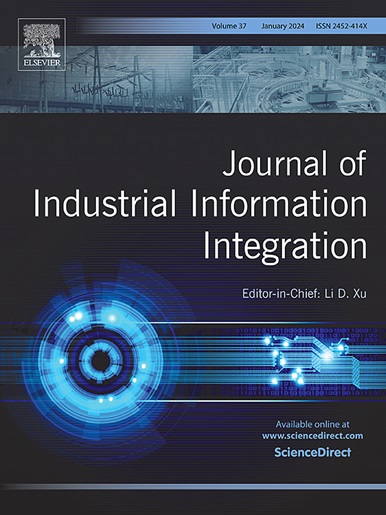EBH-IoT:基于云辅助区块链的物联网医疗系统电子健康记录的高能效安全数据收集与分发
IF 10.4
1区 计算机科学
Q1 COMPUTER SCIENCE, INTERDISCIPLINARY APPLICATIONS
引用次数: 0
摘要
健康物联网(H-IoT)与区块链技术的整合正在许多领域得到大量开发和使用,特别是在电子医疗保健领域,以收集患者的数据,即电子健康记录(EHR)。H-IoT 设备能够提供患者的实时感知数据,并对其进行处理、分析和分发。区块链为电子病历数据提供去中心化的计算、分发和存储。因此,将 H-IoT 与区块链技术相结合,可以成为设计基于 H-IoT 的去中心化电子医疗系统的合理选择。但 H-IoT 网络存在一些内在挑战,如低计算量、能源限制、安全性、能源优化、数据存储和实时数据分析等。此外,传统的基于电子病历的系统还存在数据可能丢失、安全性不足和健康记录不可更改的共识、不同机构之间的连接分散、临床数据检索方法无效等问题。本文首先研究了区块链技术在医疗系统中的性能。其次,我们提出了一种基于哈里斯鹰优化算法(HHO)的改进型聚类机制,用于电子病历的收集和共享。我们使用基于超级账本架构的电子病历(EHR)共享系统和 Matlab 对所提出的系统进行了测试和验证。在区块链网络的延迟和吞吐量方面,拟议系统分别实现了 12% 和 7% 的增量改进。与现有技术水平相比,拟议的聚类技术在活节点、能耗、吞吐量和平均传输延迟方面分别提高了 10%、12%、14% 和 16%。本文章由计算机程序翻译,如有差异,请以英文原文为准。
EBH-IoT: Energy-efficient secured data collection and distribution of electronics health record for cloud assisted blockchain enabled IoT based healthcare system
The integration of Health IoT (H-IoT) and blockchain technologies are being heavily exploited and used in many domains, especially for e-healthcare to collect the data i.e electronic health record (EHR) from the patient. The H-IoT devices have the ability to provide real-time sensory data from patients to be processed and analyzed, and distributed. Blockchain is providing decentralized computation, distribution and storage for EHR data. Therefore, the integration of H-IoT and Blockchain technologies can become a reasonable choice for the design of decentralized H-IoT-based e-healthcare systems. But the H-IoT network has some intrinsic challenges like low computation, energy constraint, security, energy optimization, data storage, and real-time data analytic. Also, conventional EHR-based systems suffer from issues such as the potential loss of data, inadequate security and consensus on the unchangeable nature of health records, fragmented connections between different institutions, and ineffective clinical data retrieval methods, among other challenges. In this article, first, we study the performance of blockchain technology in the healthcare system. Second, we propose an improved Harris Hawk Optimization algorithm (HHO) based clustering mechanism for the collection and sharing of EHR. The proposed system was tested and validated using the Hyperledger-fabric based electronic healthcare record (EHR) sharing system along with Matlab. The proposed system achieves 12%, and 7% incremental improvement in terms of latency, throughput for the Blockchain networks. While the proposed clustering technique achieves 10%, 12%, 14%, and 16% improvements in alive node, energy consumption, throughput and average transmission delay compared to existing state of the art.
求助全文
通过发布文献求助,成功后即可免费获取论文全文。
去求助
来源期刊

Journal of Industrial Information Integration
Decision Sciences-Information Systems and Management
CiteScore
22.30
自引率
13.40%
发文量
100
期刊介绍:
The Journal of Industrial Information Integration focuses on the industry's transition towards industrial integration and informatization, covering not only hardware and software but also information integration. It serves as a platform for promoting advances in industrial information integration, addressing challenges, issues, and solutions in an interdisciplinary forum for researchers, practitioners, and policy makers.
The Journal of Industrial Information Integration welcomes papers on foundational, technical, and practical aspects of industrial information integration, emphasizing the complex and cross-disciplinary topics that arise in industrial integration. Techniques from mathematical science, computer science, computer engineering, electrical and electronic engineering, manufacturing engineering, and engineering management are crucial in this context.
 求助内容:
求助内容: 应助结果提醒方式:
应助结果提醒方式:


